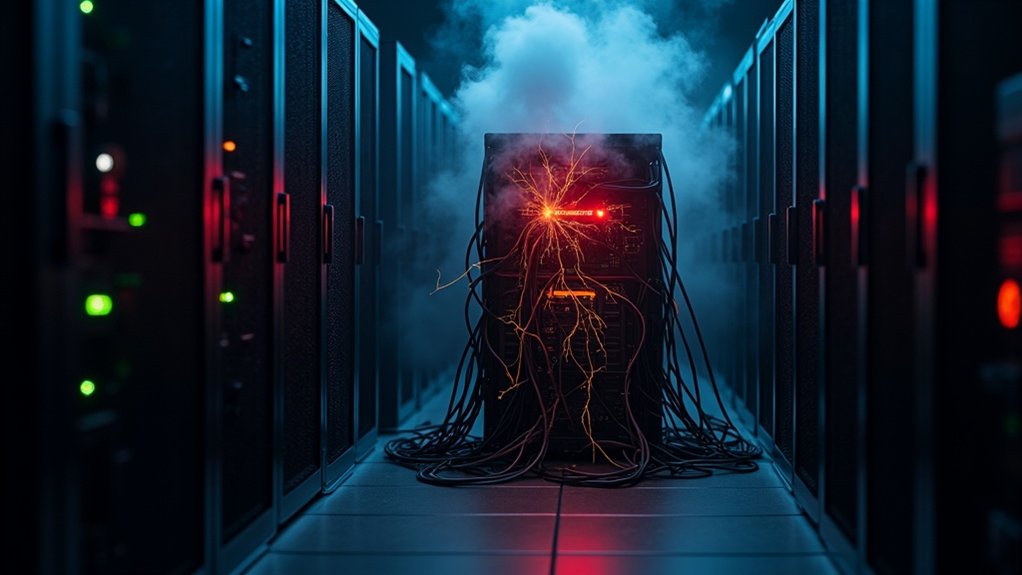Contrary to popular belief, “node trading” isn’t actually a thing in cryptocurrency. Nodes don’t trade—they validate. These network computers verify transactions, maintain blockchain copies, and distribute data. Some nodes mine or stake crypto, but trading? Nope. Nodes are the infrastructure backbone, not trading platforms. Full nodes store everything while light nodes keep partial records. The confusion probably stems from mixing up node functions with trading activities. Stick around to untangle more crypto misconceptions.
Almost everyone knows about Bitcoin these days, but few understand the backbone that keeps the whole system running: nodes. These critical connection points form the infrastructure of every blockchain network, silently receiving, validating, storing, and distributing transaction data while most crypto bros are just checking price charts.
Let’s get something straight: there’s no such thing as “node trading” in cryptocurrency. Nodes don’t trade. They validate. They maintain copies of the entire blockchain ledger. They enforce rules. Trading is what humans do with tokens on exchanges. Nodes are the invisible judges making sure nobody’s cheating the system.
Different types of nodes perform various functions across networks. Full nodes store everything—every transaction ever made. Light nodes hold partial data for efficiency. Validator nodes in Proof of Stake systems put their own tokens on the line to validate blocks. Miners in Proof of Work systems burn electricity solving math puzzles. Master nodes provide specialized services. Each plays its role in the ecosystem. These nodes work together as a decentralized system without requiring any central authority to coordinate their activities.
The validation process is surprisingly straightforward. User sends transaction. Nodes check if it’s legit—correct signature? Enough balance? Properly formatted? Passes muster? Great. Into the mempool it goes, waiting for inclusion in a block.
Then mining or validator nodes package transactions into blocks. Confirmed blocks spread across the network like gossip at a high school reunion.
Consensus mechanisms determine how nodes agree on what’s true. Proof of Work? Miners compete. Proof of Stake? Validators take turns. Other fancy systems exist too. The point is nodes must agree. This prevents double-spending and other shenanigans.
Nodes communicate in a giant mesh network, talking to multiple peers simultaneously. This creates redundancy. Resilience. New nodes joining? Existing nodes share the blockchain history. It’s a self-sustaining, self-propagating system. Running a node requires at least 600GB disk space and sufficient RAM to properly maintain blockchain data. These nodes support overall network security by preventing centralization and eliminating single points of failure that could compromise the blockchain.
Frequently Asked Questions
How Do I Start Trading Cryptocurrency Nodes?
Starting cryptocurrency node trading requires several steps.
First, research node types and choose profitable blockchain projects.
Second, set up technical infrastructure – either hardware or cloud-based servers.
Third, acquire necessary cryptocurrency for collateral or staking.
Fourth, install and configure node software following project guidelines.
Finally, join node trading platforms to buy, sell, or lease positions.
Constant monitoring is essential.
The process isn’t simple. Technical knowledge matters. Rewards can vary widely depending on the project.
What Are the Risks of Investing in Node Trading?
Node trading carries significant risks.
Technical failures can brick expensive hardware. Market volatility means node tokens might tank overnight—gone.
Security threats are constant; hackers love crypto targets. Regulatory uncertainty looms large—what’s legal today could be banned tomorrow.
Operational costs add up fast. Liquidity issues might trap investments when you need out.
Third-party services introduce additional vulnerabilities. Not to mention, the whole ecosystem changes rapidly.
Yesterday’s profitable node? Tomorrow’s paperweight.
Are There Tax Implications for Node Trading Profits?
Yes, node trading profits face significant tax implications. Most jurisdictions consider these earnings taxable income or capital gains.
Node rewards get taxed at fair market value when received. Selling node tokens? That’s potentially capital gains tax territory.
The crypto tax landscape is a mess, honestly. Different countries, different rules. Record-keeping is essential—authorities are watching crypto earnings more closely now.
Specialized tax software helps, but the regulatory environment keeps shifting. No escaping the tax man, even in crypto.
Which Cryptocurrencies Offer the Best Node Trading Opportunities?
Ethereum tops the list with its shift to PoS, offering solid staking rewards.
Bitcoin provides stability but demands serious hardware.
Polkadot and Cardano shine with their NPoS and PoS systems respectively, rewarding validators handsomely.
Solana’s high-throughput network pays well for performance.
Masternodes on Dash and PIVX require hefty collateral but deliver better returns.
Emerging players? Avalanche and Algorand look promising.
The best choice depends on your capital, technical skills, and risk appetite. No free lunch here.
Can I Automate My Node Trading Strategy?
Yes, node trading strategies can be automated.
Traders use software bots to handle repetitive tasks like staking, validating transactions, and monitoring network conditions. Scripts in Python, JavaScript, or Go connect via APIs to execute commands automatically.
No more babysitting nodes 24/7. Automation scales operations across multiple networks simultaneously—pretty efficient.
But there’s always a catch: technical knowledge required, security risks present, and bugs happen. Regular maintenance still necessary. Not exactly set-it-and-forget-it.









